Satas D., Tracton A.A. (ed.). Coatings Technology Handbook
Подождите немного. Документ загружается.

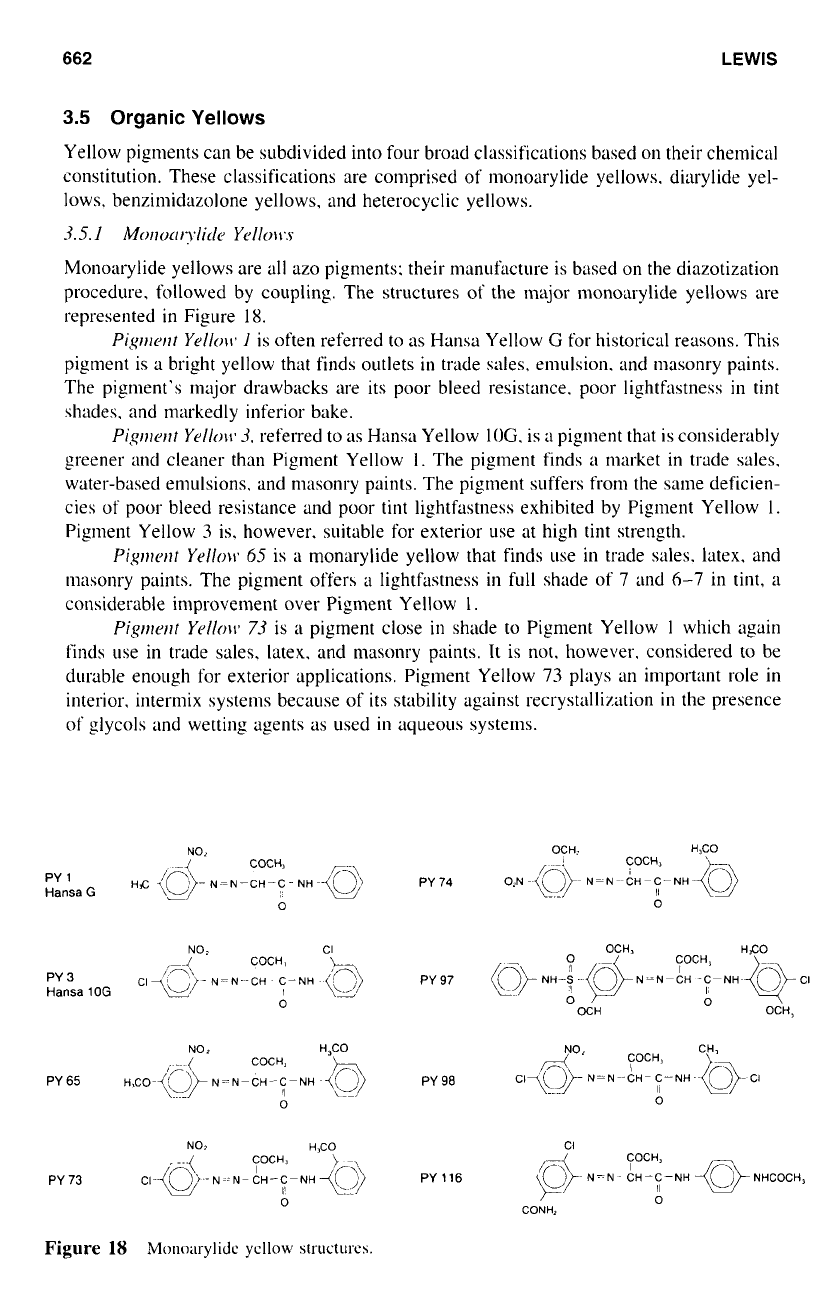
662
LEWIS
3.5
Organic Yellows
Yellow pigments can be subdivided into four broad classifications based
on
their chemical
constitution. These classifications are comprised of monoarylide yellows. dinrylide yel-
lows, benzimidazolone yellows, and heterocyclic yellows.
3.5.
l
Morlolrr~YlilIP
YC.llO\C~.S
Monoarylide yellows are all azo pigments: their manufacture is based
on
the diazotization
procedure, followed by coupling. The structures
of
the major monoarylide yellows are
represented
in
Figure
18.
Pigrrwrlt
Yellou~
l
is often referred to
as
Hansa Yellow
G
for historical reasons. This
pigment is a bright yellow that finds outlets
in
trade sales. emulsion. and masonry paints.
The pigment's major drawbacks are its poor bleed resistance. poor lightfastness
in
tint
shades. and markedly inferior bake.
Pigr~~er~t
Yello\1~3.
referred
to
as
Hansa
Yellow
10G.
is
;I
pigment that is considerably
greener and cleaner than Pigment Yellow
1.
The pigment finds
;I
market
in
trade sales.
water-based emulsions. and masonry paints. The pigment suffers from the same deficien-
cies of poor bleed resistance and poor
tint
lightfastness exhibited by Pigment Yellow
1.
Pigtnent Yellow 3 is, however, suitable for exterior use at high
tint
strength.
Pigr~~rr~t
Yello~~
6.5
is
a
monarylide yellow that finds use
in
trade sales. latex, and
masonry paints. The pigment offers
a
lightfastness
in
full
shade of 7 and 6-7 in
tint,
a
considerable improvement over Pigment Yellow
1.
Pigruerlt
Yello\t*
73
is
a
pigment close
in
shade to Pigment Yellow
1
which again
finds use
in
trade sales. latex, and masonry paints. It
is
not. however. considered to be
durable enough for exterior applications. Pigment Yellow 73 plays an important role
in
interior. intermix systems because of its stability against recrystallization
in
the presence
of glycols and wetting agents as used
in
aqueous systems.
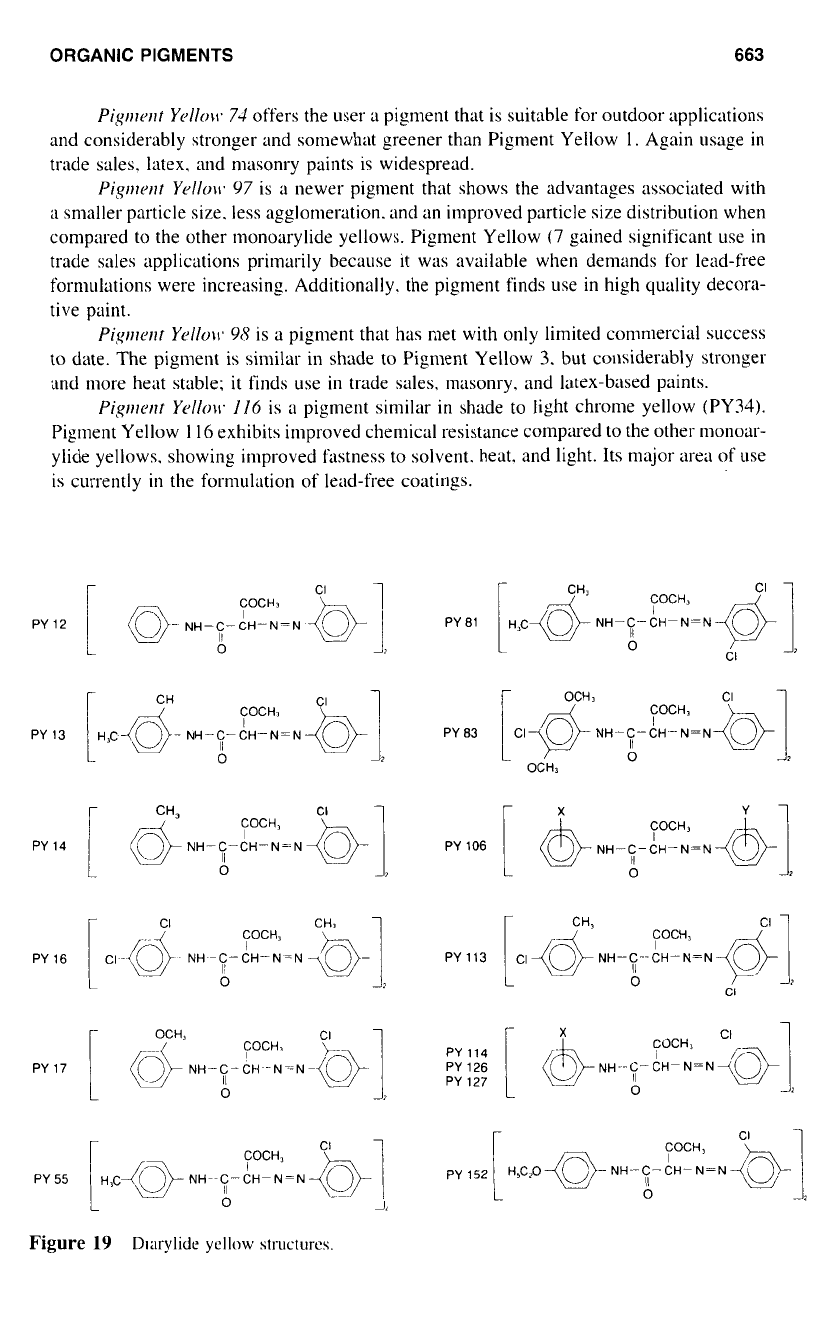
ORGANIC PIGMENTS
663
Pigmwt
Yellorc.
74
offers the user
;I
pigment that is suitable for outdoor applications
and considerably stronger and somewhat greener than Pigment Yellow
1.
Again usage
in
trade sales. latex. and masonry paints is widespread.
Pigmwt
Ye/lo,c,
97
is
;I
newer pigment that shows the advantages associated with
a
smaller particle size. less agglomeration. and an improved particle size distribution when
cornpared to the other monoarylide yellows. Pigment Yellow
(7
gained significant use
in
trade sales applications primarily because
it
was available when demands for lead-free
formulations were increasing. Additionally. the pigment finds use
in
high quality decora-
tive paint.
Pip11erlt
YcJllm.
98
is a pigment that has met with only limited commercial success
to date. The pigment is similar in shade to Pigment Yellow
3.
but considerably stronger
and more heat stable;
it
finds use
in
trade sales. masonry. and latex-based paints.
Pig111er1t
Yc.llo\\.
116
is
a
pigment similar
in
shade to light chrome yellow (PY3.1.).
Pigment Yellow
1
16
exhibits improved chemical resistance compared
to
the other monoar-
ylide yellows. showing improved fwness
to
solvent. heat. and light. Its major area of use
is currently
in
the formulation of lead-free coatings.
Figure
19
D~nrylide
ycllow
structures
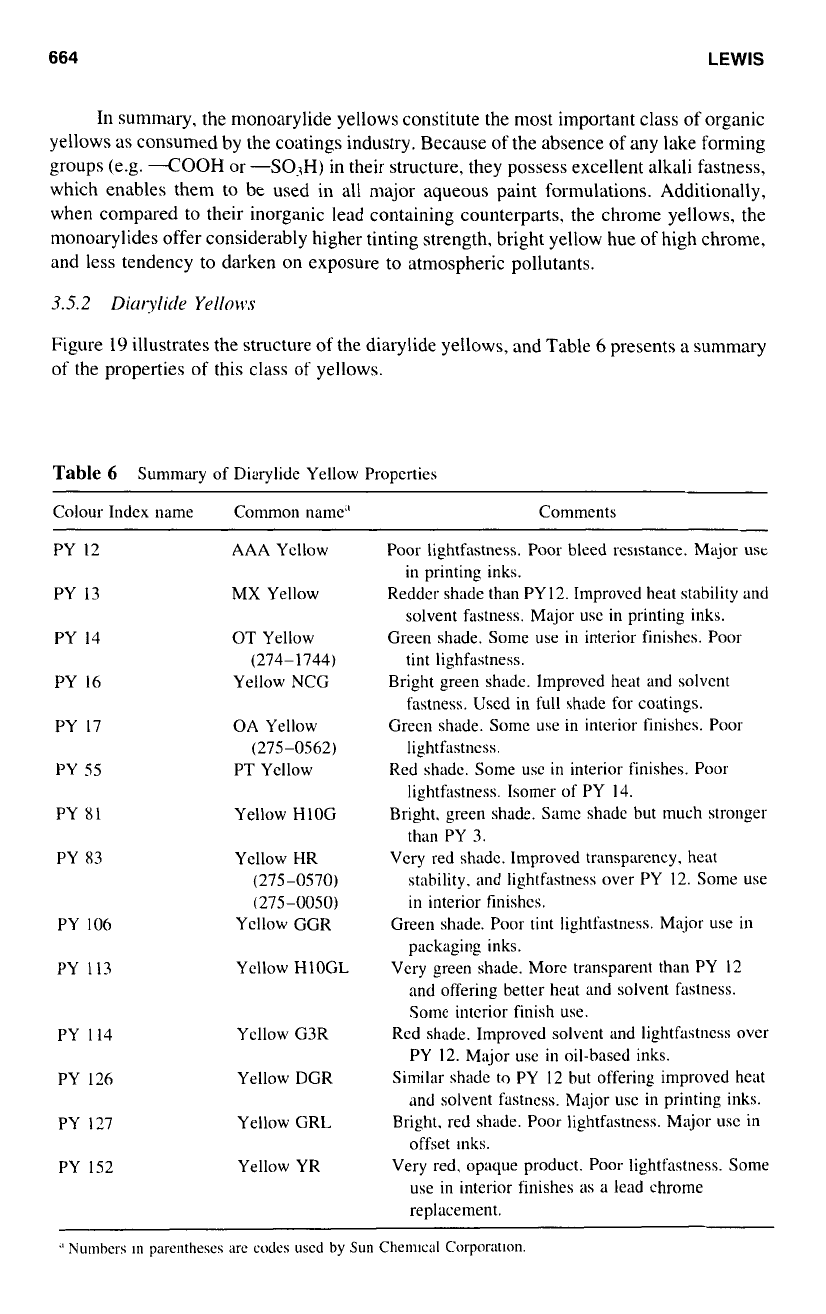
664
LEWIS
In
summary, the monoarylide yellows constitute the most important class of organic
yellows as consumed by the coatings industry. Because
of
the absence
of
any lake forming
groups (e.g.
"COOH
or
--SO3H)
in their structure, they possess excellent alkali fastness,
which enables them to be used in all major aqueous paint formulations. Additionally,
when compared to their inorganic lead containing counterparts, the chrome yellows, the
monoarylides offer considerably higher tinting strength, bright yellow hue of high chrome,
and less tendency to darken on exposure to atmospheric pollutants.
3.5.2
Diutylirle
Yellmvs
Figure
19
illustrates the structure
of
the diarylide yellows, and Table
6
presents a summary
of
the properties
of
this class
of
yellows.
Table
6
Summary of Diarylide Yellow Properties
Colour Index name Common name" Comments
PY
12
PY
13
PY 14
PY
16
PY 17
PY
55
PY
81
PY
x3
PY
106
PY
113
PY 114
PY 126
PY 17-7
PY
152
AAA
Yellow
MX
Yellow
OT Yellow
(274-1744)
Yellow NCG
OA
Yellow
PT Yellow
(275-0562)
Yellow
H
IOG
Yellow HR
(275-0570)
(275-0050)
Yellow GGR
Yellow
HlOGL
Yellow
G3R
Yellow DGR
Yellow GRL
Yellow YR
Poor lightfastness. Poor bleed rcslstance. Major use
in printing inks.
Redder shade than PY 12. Improved heat stability and
solvent fastness. Major use in printing inks.
Green shade. Some use
in
interior finishes. Poor
tint lighfastness.
Bright green shade. Improved heat and solvent
fastness. Used in full shade for coatings.
Green shade. Some use in interior finishes. Poor
lightfastness.
lightfastness. Isomer of PY 14.
than PY
3.
stability. and lightfastness over PY
12.
Some use
in
interior finishes.
Red shade. Some
use
in
interior finishes. Poor
Bright. green shade. Same shade
but
much stronger
Very red shade. Improved transparency, heat
Green shade. Poor tint lightfastness. Major use in
packaging inks.
Very green shade. More transparent than PY 12
and offering better heat and solvent fastness.
Some
interior finish use.
Red shade. Improved solvent and lightfastness over
PY
12.
Major
use
in
oil-based inks.
Similar shade
to
PY
12
but offering improved heat
and solvent fastness. Major
use
in printing inks.
Bright. red shade. Poor lightfastness. Major
use
in
offset Inks.
Very red, opaque product. Poor lightfastness. Some
use in interior finishes
21s
a lead chrome
replacement.
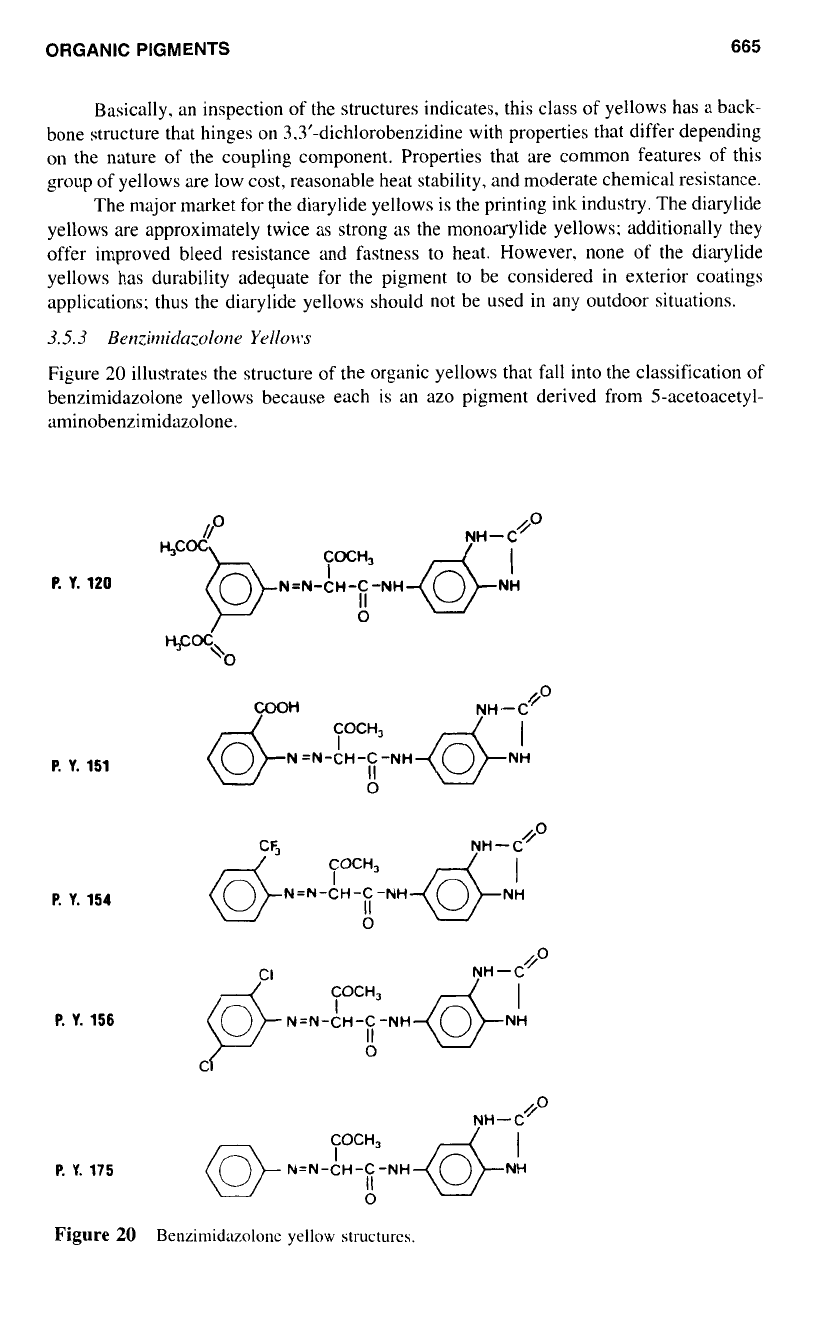
ORGANIC
PIGMENTS
665
Basically, an inspection of the structures indicates, this class
of
yellows has a back-
bone structure that hinges
on
3.3"dichlorobenzidine with properties that differ depending
on
the nature
of
the coupling component. Properties that are common features
of
this
group
of
yellows are low cost, reasonable heat stability, and moderate chemical resistance.
The major market for the diarylide yellows is the printing ink industry. The diarylide
yellows are approximately twice as strong
as
the monoarylide yellows; additionally they
offer improved bleed resistance and fastness
to
heat. However. none
of
the diarylide
yellows has durability adequate for the pigment to be considered
in
exterior coatings
applications; thus the diarylide yellows should not be used in any outdoor situations.
3.5.3
Ben,-inlirln,-olorle
YL'IIoH~s
Figure
20
illustrates the structure
of
the organic yellows that fall into the classification of
benzimidazolone yellows because each is an azo pigment derived from 5-acetoacetyl-
aminobenzimidazolone.
1.0
P.
Y.
120
N=N-CH-C-NH NH
Y
rnr'
P.
Y.
175
Figure
20
Benzimidnzolonc
yellow
structures.
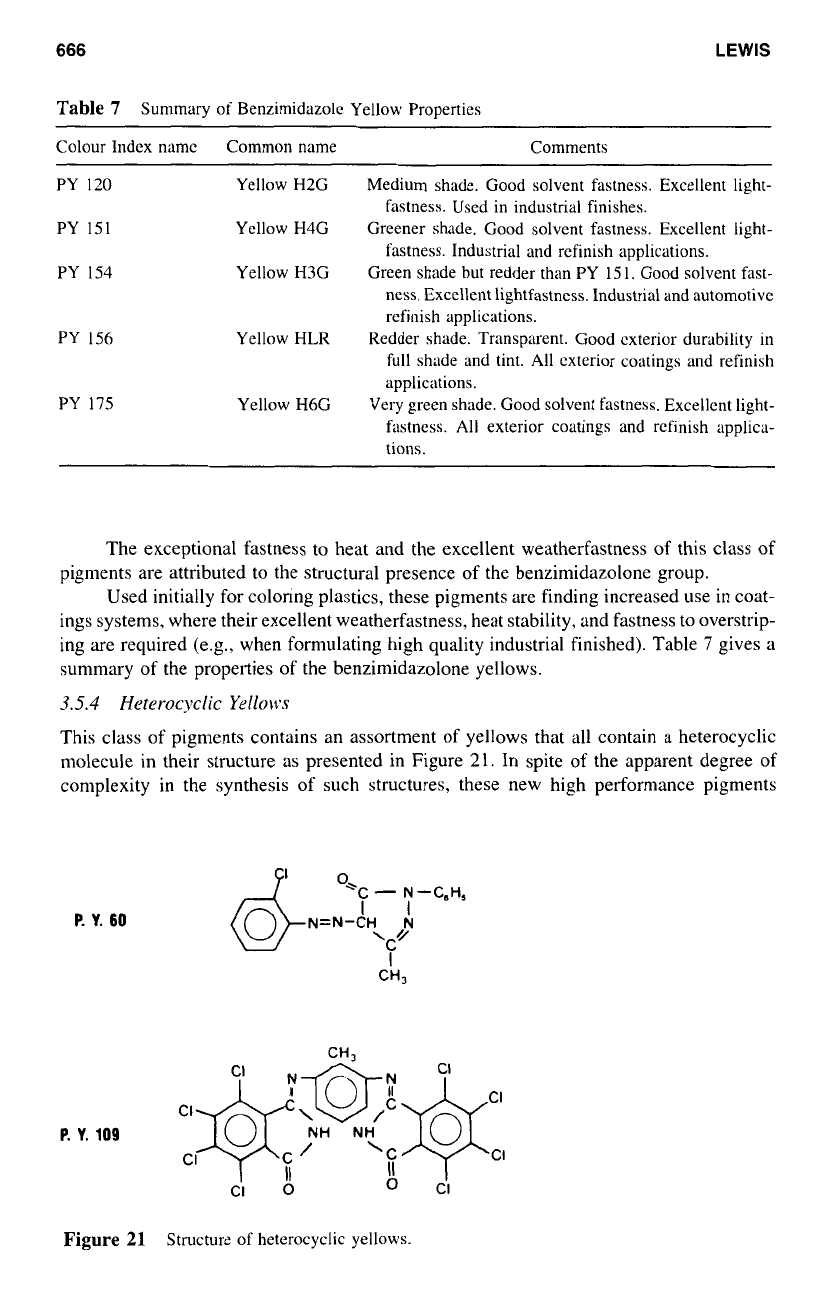
666
LEWIS
Table
7
Summary
of
Benzimidazole Yellow Properties
Colour Index namc Common name Comments
PY
120
Yellow H2G
Medium shade. Good solvent fastness. Excellent light-
PY
151
Ycllow H4G
Greener shade. Good solvcnt fastness. Excellent light-
fastness. Used in industrial finishes.
fastness. Industrial and refinish applications.
PY
154
Yellow H3G Green shade but redder than PY
15
1.
Good solvent fast-
ness. Excellent lightfastness. Industrial and automotive
rcfinish applications.
PY
156
Yellow HLR Redder shade. Transparent. Good cxterior durability in
full shade and tint. All cxterior coatings and refinish
applications.
PY
175
Yellow H6G Very green shade. Good solvent fastness. Excellcnt light-
fastness.
All
exterior coatings and refinish applica-
tions.
The exceptional fastness to heat and the excellent weatherfastness
of
this class
of
pigments are attributed
to
the structural presence of the benzimidazolone group.
Used initially for coloring plastics, these pigments are finding increased use in coat-
ings systems, where their excellent weatherfastness, heat stability, and fastness
to
overstrip-
ing are required (e.g.. when formulating high quality industrial finished). Table
7
gives a
summary of the properties of the benzimidazolone yellows.
3.5.4
Heterocyclic
Yellort’s
This class of pigments contains an assortment of yellows that all contain a heterocyclic
molecule in their structure as presented in Figure
21.
In spite
of
the apparent degree
of
complexity
in
the synthesis
of
such structures, these new high performance pigments
CH,
CH,
P.
Y.
109
C’
Cl
0
Figure
21
Structure
of
heterocyclic yellows.
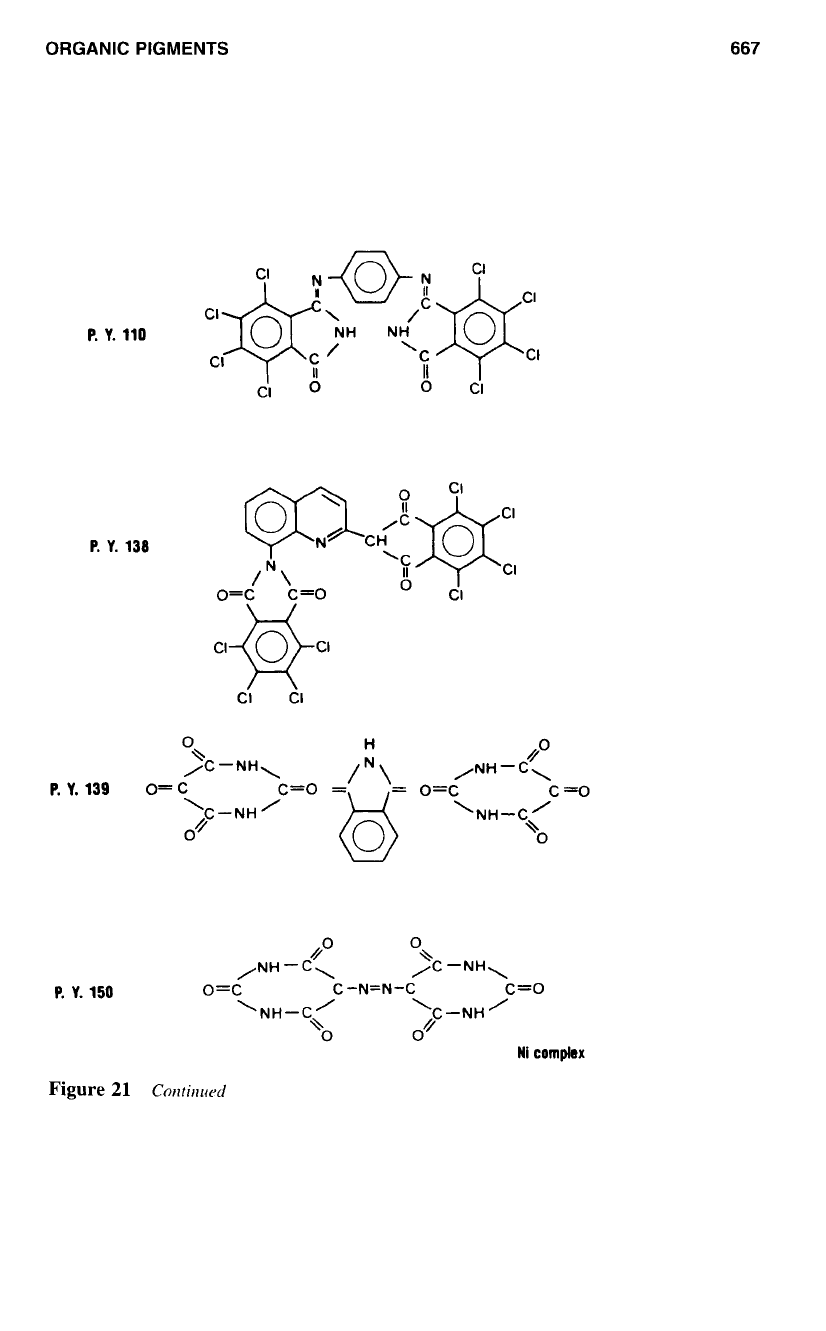
ORGANIC
PIGMENTS
667
P.
Y.
110
P.
Y.
130
\
-@l
/
/
C
0
II
NH
NH
\
?
P.
Y.
150
0=C C -N=N-C
c=o
\NH-C/
'C-NH
/
"0
04
Mi
complex
Figure
21
Corlrirllrrd
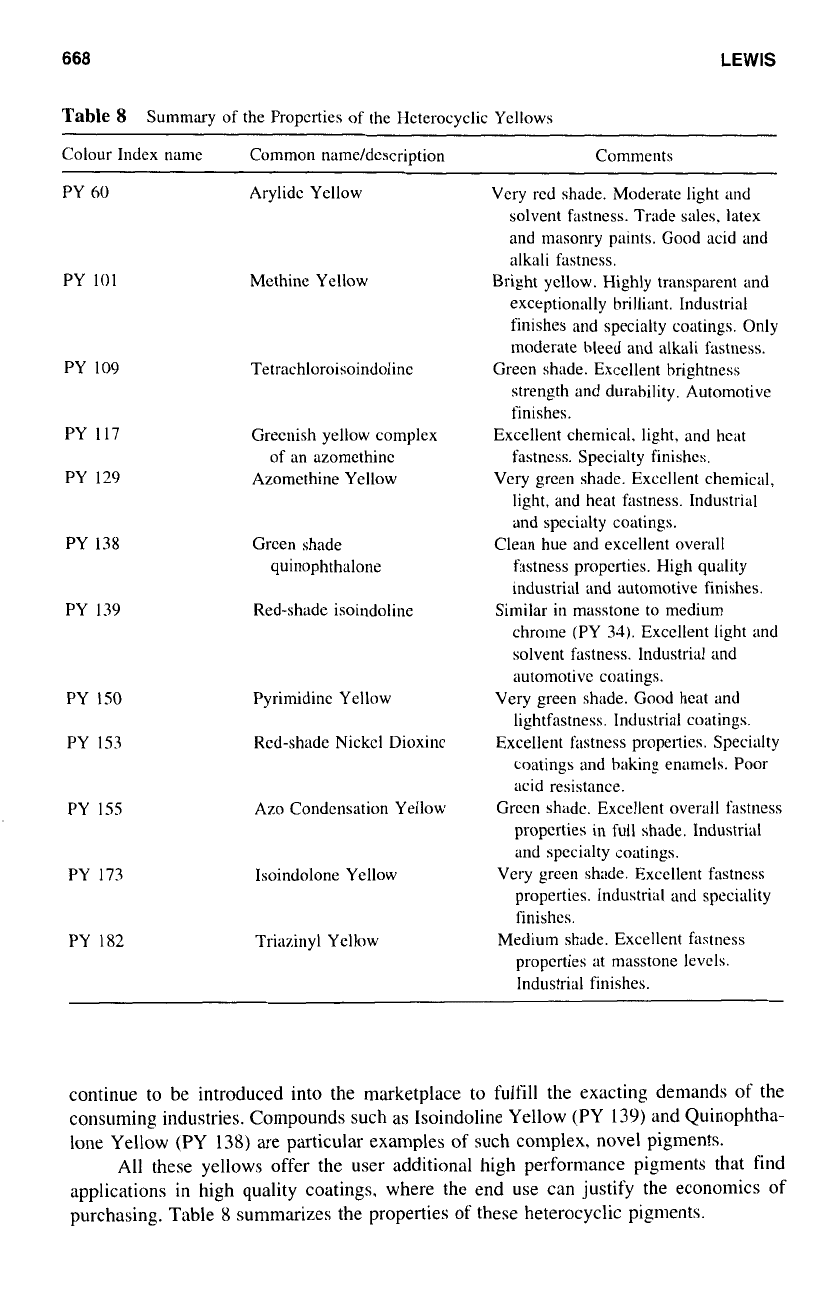
668
LEWIS
Table
8
Summary of the Propcrtics of the Hcterocyclic Ycllows
Colour Index name Common name/dcscription Comments
PY
60
PY
101
PY
109
PY
117
PY
129
PY
138
PY
139
PY
IS0
PY
IS3
PY
15s
PY
173
PY
182
Arylidc Yellow
Mcthinc Yellow
Tetrachloroisoindolinc
Greenish yellow complex
of an azomcthinc
Azomcthine Ycllow
Grcen shade
quinophthalone
Red-shade isoindoline
Pyrimidine Yellow
Rcd-shade Nickcl Dioxine
Azo Condcnsation Yellow
Isoindolone Yellow
Triazinyl Yellow
Vcry rcd shade. Moderate light and
solvent fastness. Trade sales. latex
and masonry paints. Good acid and
alkali fastncss.
Bright yellow. Highly transparent and
exceptionally brilliant. Industrial
finishes and specialty coatings. Only
moderate bleed and alkali fastness.
Grecn shade. Excellent brightness
strength and durahility. Automotive
finishes.
Excellent chemical. light, and hcat
fastncss. Specialty finishes.
Vcry grcen shade. Excellent chemical,
light, and heat fastness. Industrial
and specialty coatings.
fastness propcrties. High quality
industrial and automotivc finishes.
Clean hue and excellent overall
Similar in masstone to medium
chrome (PY
33).
Excellent light and
solvent fastness. Industrial and
automotivc coatings.
Very green shade. Good hcat and
lightfastness. Industrial coatings.
Excellent fastncss properties. Specidty
coatings and baking ennmcls. Poor
acid resistance.
Grccn shade. Exccllcnt overall fastness
propcrties in full shade. Industrial
and specialty coatings.
Vcry grcen shade. Excellent fastncss
properties. Industrial and speciality
finishcs.
Medium shade. Excellent fastness
propcrties at masstone levcls.
Industrial finishes.
continue
to
be introduced into the marketplace
to
fulfill the exacting demands of the
consuming industries. Compounds such as Isoindoline Yellow (PY 139) and Quinophtha-
lone Yellow
(PY
138) are particular examples
of
such complex, novel pigments.
All these yellows offer the user additional high performance pigments that find
applications
in
high quality coatings. where the end use can justify the economics of
purchasing. Table
8
summarizes the properties of these heterocyclic pigments.
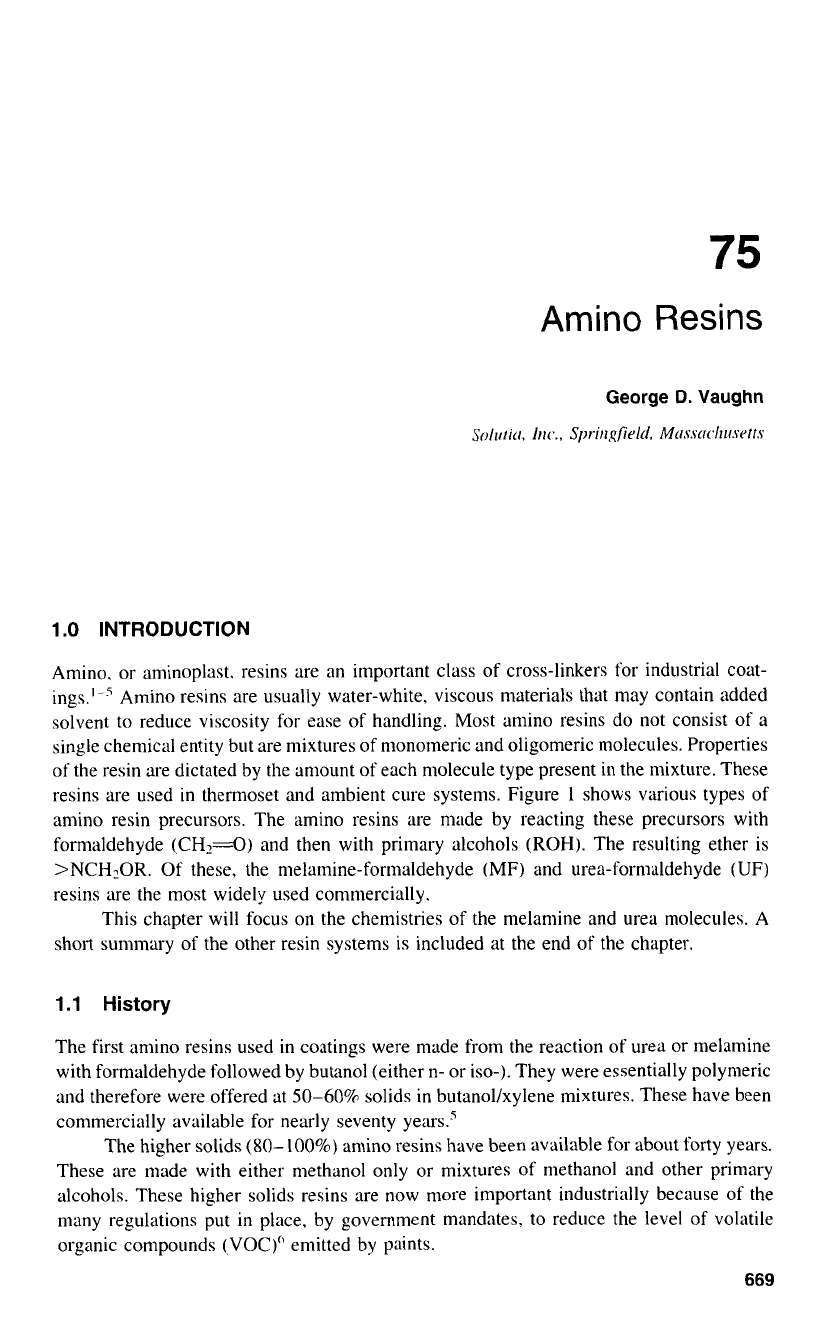
75
Amino
Resins
1
.O
INTRODUCTION
Amino. or aminoplast. resins are an important class of cross-linkers for industrial coat-
ings.'-5 Amino resins are usually water-white, viscous materials that may contain added
solvent
to
reduce viscosity for ease
of
handling.
Most
amino resins do
not
consist
of
a
single chemical entity but are mixtures of monomeric and oligomeric molecules. Properties
of the resin are dictated by the amount of each molecule type present in the mixture. These
resins are used in thermoset and ambient cure systems. Figure l shows various types of
amino resin precursors. The amino resins are made by reacting these precursors with
formaldehyde (CH2==O) and then with primary alcohols (ROH). The resulting ether is
>NCH,OR. Of these, the melamine-formaldehyde
(MF)
and urea-formaldehyde (UF)
resins are the most widely used commercially.
This chapter will focus on the chemistries of the melamine and urea molecules. A
short summary of the other resin systems is included at the end of the chapter.
1.1 History
The first amino resins used
in
coatings were made from the reaction of urea or melamine
with formaldehyde followed by butanol (either n- or iso-). They were essentially polymeric
and therefore were offered
at
50-60%
solids
in
butanol/xylene mixtures. These have been
commercially available for nearly seventy years.'
The higher solids
(80-
100%)
amino resins have been available for about forty years.
These are made with either methanol only or mixtures
of
methanol and other primary
alcohols. These higher solids resins are now more important industrially because of the
many regulations put in place, by government mandates,
to
reduce the level
of
volatile
organic compounds (VOC)" emitted by paints.
669
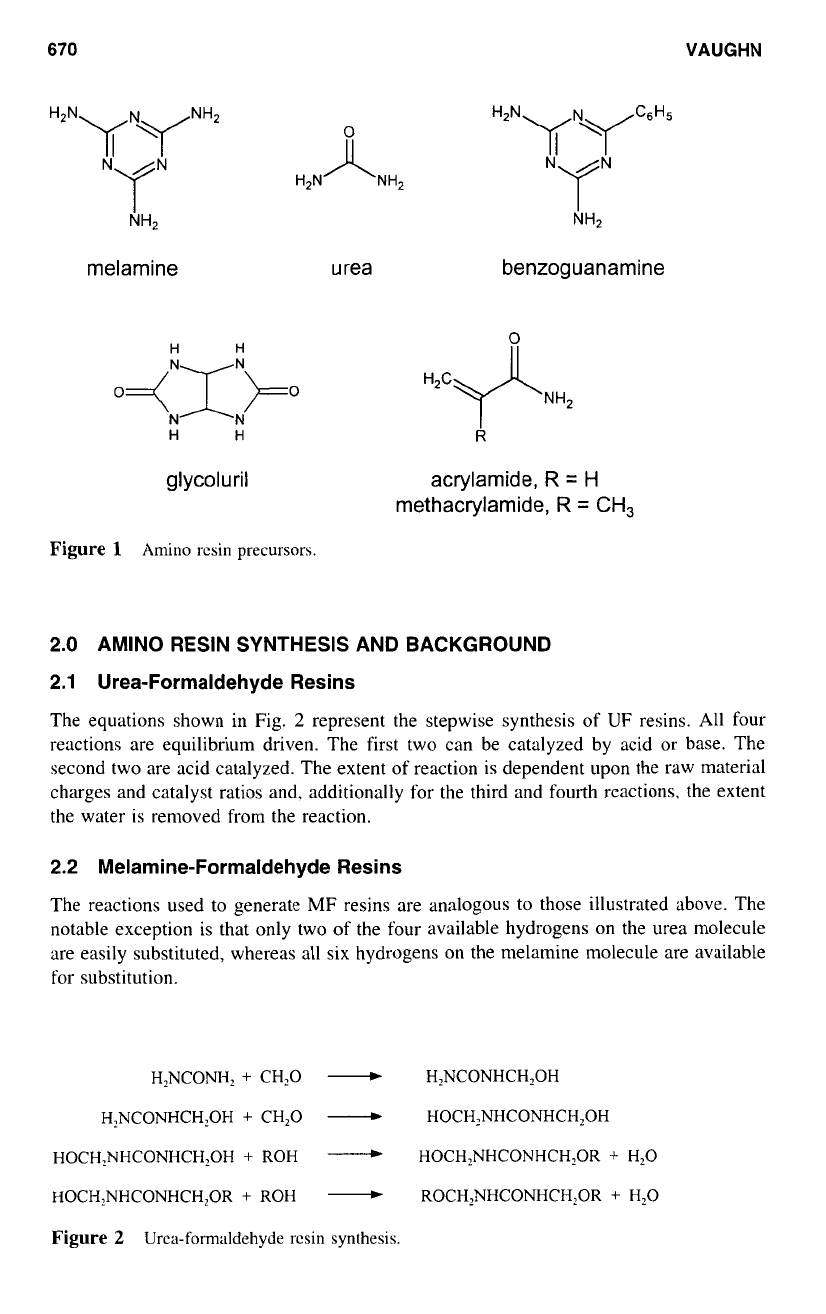
670
VAUGHN
melamine
H
H
o=<"xN)=o
N
H
N
H
glycoluril
U
rea
benzoguanamine
I
R
acrylamide,
R
=
H
methacrylamide,
R
=
CH,
Figure
1
Amino
resin
precursors.
2.0
AMINO RESIN SYNTHESIS AND BACKGROUND
2.1
Urea-Formaldehyde Resins
The equations shown in Fig.
2
represent the stepwise synthesis
of
UF
resins. All four
reactions are equilibrium driven. The first two can be catalyzed by acid or base. The
second two are acid catalyzed. The extent
of
reaction is dependent upon the raw material
charges and catalyst ratios and, additionally for the third and fourth reactions. the extent
the water is removed from the reaction.
2.2
Melamine-Formaldehyde Resins
The reactions used to generate
MF
resins are analogous to those illustrated above. The
notable exception is that only two of the four available hydrogens on the urea molecule
are easily substituted, whereas all six hydrogens on the melamine molecule are available
for substitution.
H,NCONH,
+
CHzO
-
H,NCONHCH20H
HzNCONHCHzOH
+
CH,O HOCH,NHCONHCH,OH
HOCHZNHCONHCH,OH
+
ROH
--"+
HOCHzNHCONHCHzOR
+
H,O
HOCH2NHCONHCH,0R
+
ROH
-
ROCHzNHCONHCHzOR
+
H,O
Figure
2
Urea-formaldehyde
resin
synthesis.
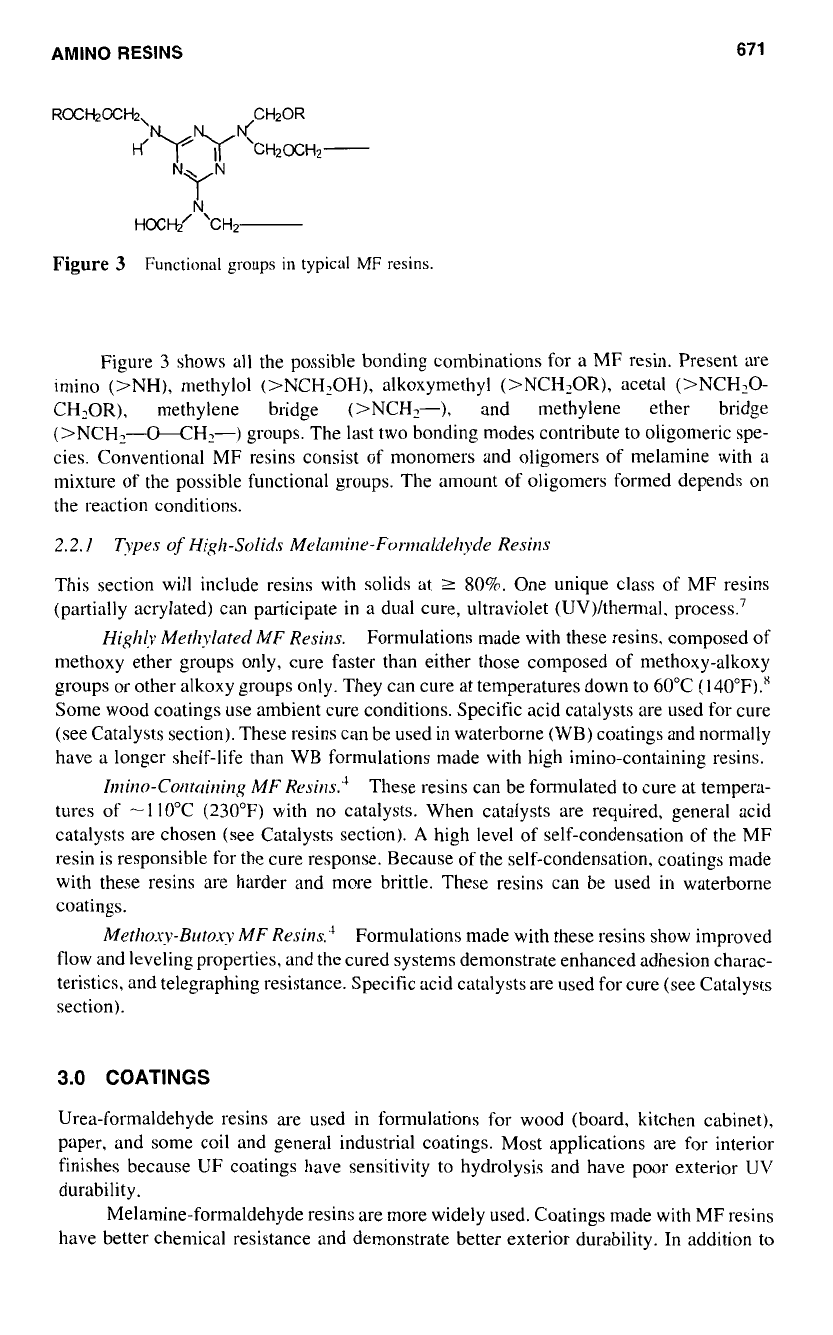
AMINO
RESINS
671
rs
HOCl4-z' 'CH2-
Figure
3
Functional groups
in
typical
MF resins.
Figure
3
shows all the possible bonding combinations for a MF resin. Present are
imino (>NH), methylol (>NCH,OH), alkoxymethyl (>NCH,OR), acetal (>NCH,O-
CH20R), methylene bridge (>NCH,-), and methylene ether bridge
(>NCH2aH,-) groups. The last two bonding modes contribute to oligomeric spe-
cies. Conventional MF resins consist of monomers and oligomers of melamine with a
mixture
of
the possible functional groups. The amount of oligomers formed depends
on
the reaction conditions.
2.2.
l
Types
of
High-Solids
Me1~111i17e-F~~~1~~al~lel~y~le
Resins
This section will include resins with solids at
2
80%.
One unique class of MF resins
(partially acrylated) can participate in
a
dual cure, ultraviolet (UV)/thermal. process.'
Highly Methylatecl MF Resins.
Formulations made with these resins. composed of
methoxy ether groups only, cure faster than either those composed of methoxy-alkoxy
groups or other alkoxy groups only. They can cure at temperatures down to 60°C (140"F).X
Some wood coatings use ambient cure conditions. Specific acid catalysts are used for cure
(see Catalysts section). These resins can be used
in
waterborne (WB) coatings and normally
have a longer shelf-life than WB formulations made with high imino-containing resins.
I~l~ino-Cnntr~ining MF Resins."
These resins can be formulated to cure at tempera-
tures of
-
110°C
(230°F)
with
no
catalysts. When catalysts are required, general acid
catalysts are chosen (see Catalysts section).
A
high level
of
self-condensation of the MF
resin is responsible for the cure response. Because of the self-condensation, coatings made
with these resins are harder and more brittle. These resins can be used
in
waterborne
coatings.
Metimy-Butoxy MF Resins."
Formulations made with these resins show improved
flow and leveling properties, and the cured systems demonstrate enhanced adhesion charac-
teristics, and telegraphing resistance. Specific acid catalysts are used for cure (see Catalysts
section).
3.0
COATINGS
Urea-formaldehyde resins are used in formulations for wood (board, kitchen cabinet),
paper. and some coil and general industrial coatings. Most applications are for interior
finishes because UF coatings have sensitivity to hydrolysis and have poor exterior UV
durability.
Melamine-formaldehyde resins are more widely used. Coatings made with MF resins
have better chemical resistance and demonstrate better exterior durability. In addition to
